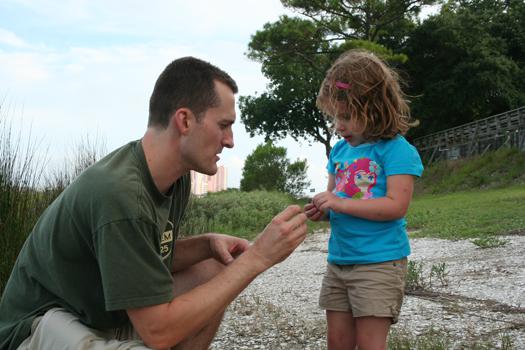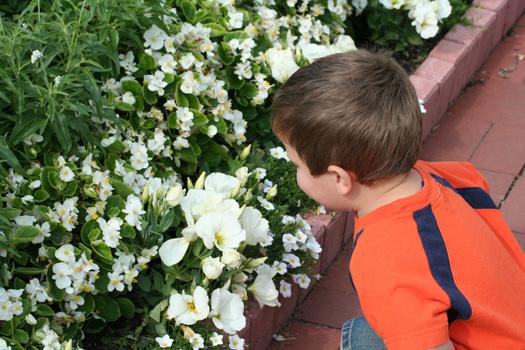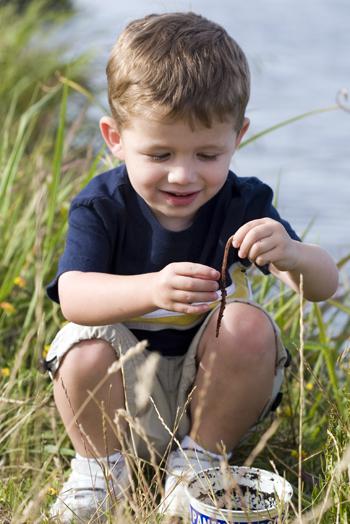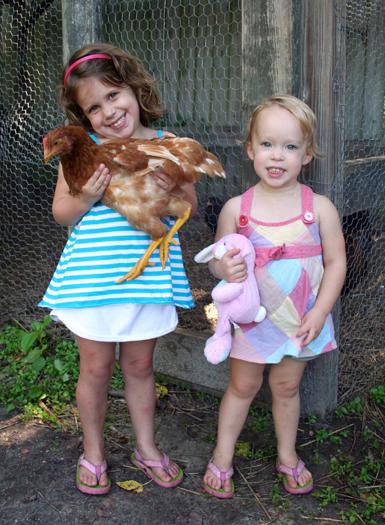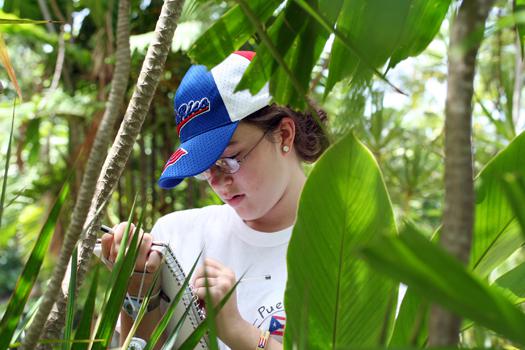Right at your doorstep may be many of the answers to the social, educational, and health challenges faced by children, parents, and teachers in the United States.
People spend approximately 90 percent of their time indoors (Infante-Rivard, 1993; U.S. EPA, 2009). Spending time outside with children in natural environments can increase physical activity, connect families with one another, and connect children with nature. However, for a variety of reasons, children today spend less time playing outdoors than any previous generation (Louv, 2005).
Why Children Are Inside
In the 1970s, the rising number of mothers in the workforce resulted in less time at home and less opportunity for time outside. In addition, parents feel they have little free time to spend outdoors and report staying inside to avoid air pollution and crime (Rivkin, 1999; White, 2004). Another factor has been technology, which now includes television, text messaging, video games, iPods, and the internet. Time spent using technology replaces walking, playing ball, and building tree houses. Children between the ages of 6 months and 6 years spend an average of 1.5 hours a day with electronic media, and youth ages 8 to 18 spend an average of 6.5 hours a day with electronic media (Kaiser Family Foundation, 2006).
Think back to your childhood. What did you enjoy most when you played outdoors? Maybe you made messy mud pies, swung on a vine, waded in the water, or played hide-and-seek in the cornfields. These opportunities are not available to many in the current generation (White, 2004). Today most young and school-age children spend a great deal of their waking hours indoors in classroom settings, child care programs, or at home.
Myth Busters
Often when families are challenged to make time to be outdoors, they face the following concerns:
It is unsafe
Some parents believe that children are unsafe outdoors. Eighty-two percent of mothers with children between the ages of 3 and 12 cited crime and safety as concerns (Clements, 2004). However, violent crimes against young people are well below 1975 levels (Louv, 2005). What has increased is television reporting of crime, leaving viewers with the impression that crime has risen.
We don’t have time
Prioritizing time together out of doors as part of the family routine will pay off in myriad ways, including health, communication, relationships, commitment, environmental stewardship, and responsibility. All of these benefits, in addition to many others, save time in the long run. One study shows that children with active parents are more active themselves (Hinkley et al., 2008).
It is unhealthy
Many people have concerns about pollution, sun, pollen, bugs, and depletion of the ozone layer. However, with attention to wearing proper clothing, hats, and sunscreen and to monitoring air quality, the outdoors is a very healthy place to spend time and has many health benefits.
Why Children Should Be Outside
Spending time with your family outside has many benefits. Going outside has been shown to reduce obesity, contribute to better health, reduce media addiction, and counteract the effects of attention deficit disorder and other learning problems (Kuo & Taylor, 2004; Burdette & Whitaker, 2005; Bell & Dyment, 2006).
Health
Over the past three decades, childhood obesity has risen to epidemic proportions (CDC, 2004). Collectively, this trend has been influenced by a complex set of issues, including a decrease in exercise. Time spent outdoors strongly correlates with increased physical activity and fitness in children (Sallis et al., 2003; Moore et al., 2003; Finn, Johannsen, & Specker, 2002). In addition, spending time outside in the fresh air minimizes exposure to indoor air pollutants, including mold, lead, asbestos, and second-hand smoke. Air within homes and other buildings can be more seriously polluted than the outdoor air (U.S. EPA, 2009). Thus, for many people, the risks to health from exposure to indoor air pollution may be greater than risks from outdoor pollution (U.S. DHHS, 2006).
Learning
Spending time in nature enhances learning. Children learn social skills by interacting with other children, with adults, and even with objects and natural materials found in the environment. The environment can serve a valuable educational purpose when it is set up to expose children to opportunities to explore, question, and develop theories about how things work. Studies of children in schoolyards with both green areas and manufactured play areas found that children engaged in more creative forms of play in green areas, and they also played more cooperatively (Bell & Dyment, 2006). Researchers have found (Kuo & Sullivan, 2001) that the more wilderness-like the setting, the more improved the children’s behavior. For example, playing outside in forests and open spaces has been shown to calm children with attention deficit disorder (ADHD) more than playing organized sports in recreational park fields. In addition, “green” settings reduce ADHD symptoms more than active play in indoor gymnasiums or outdoor play on paved surfaces (Kuo & Faber Taylor, 2004). Time spent in nature is measurably more “attention-restoring” than indoor leisure activity such as television watching or video games (Faber Taylor, Kuo, & Sullivan, 2001; Kuo & Faber Taylor, 2004).
Strategies for Encouraging Outdoor Activity
Plan for outdoor time as part of family routines. Routines are important to young children because they feel safer when they know what to expect. A family dinner followed by a walk in the neighborhood, bath time, story time, then bedtime is an example of an evening family ritual. As children grow, add biking, skating, gardening, and other family-connecting activities to keep the basic routine and add various challenges along the way. As children become more mobile, and certainly once they are able to drive, monitoring who they are with and where they go becomes more difficult. Setting the standard to be outdoors, care for the environment, and spend time with family are values to instill early in a child’s life. We’ve included a list of activities to consider for fostering connectedness while enjoying the outdoors. Consider these actions when you are with your child:
Leave No Trace! Do you model good environmental care by recycling, reusing, and picking up litter?
Respect Nature! Are you teaching children how to coexist with the other “critters” in nature, recognizing that there are good bugs so we don’t just smash them all? Even if you are scared or uncertain of a creature you encounter, model good science behavior and ask questions (such as, “I wonder why salamanders can move so fast?”).
Observe Closely! Do the snakes have spots or stripes? Are you both learning by identifying and looking up the names for birds, bugs, snakes, and plants? Keep a journal of what you see and hear.
Use All Your Senses! Are the leaves of a plant prickly, hairy, leathery, or smooth? Can you tell what kind of bird that is by the call? When you know it is safe, taste the flowers, herbs, and vegetables. What do you smell?
Take Time! Don’t rush. Get down on the child’s level and spend a few minutes. Model patience.
Encourage Curiosity! Ask questions! Wherever you go, do you instill a sense of curiosity? Why do birds scratch in the dirt? How can I ask questions, lookup the answers, notice, touch, and feel?
Interact! Without being too intrusive, pay attention to what children want to explore and learn about in their surroundings. Ask questions that stretch their imagination and thinking. Challenge them to notice and interact with the environment around them. Ensure that there are opportunities to make choices.
Explore Resources! Visit and participate in programs at the library, a nature center, a community or demonstration gar den, or local parks.
Advocate! Encourage your community to invest in open spaces for outdoor recreation. Access to attractive outdoor green environments inspires individuals to spend longer periods of time outside, engaged in higher levels of physical activity in the fresh air and sunlight (Rivkin, 2000).
What values are you passing along? How to care for nature? How to use and reuse natural resources? How to be active outdoors, how to spend leisure time?
Activities to Connect with Children Outdoors
- Collect rocks and pinecones
- Feed the birds
- Wash the dog
- Make a kite
- Read together on a blanket under a tree
- Play hopscotch
- Build a fort
- Plan a trip
- Make a picnic
- Move to music outside
- Go fishing
- Climb a tree
- Stargaze
- Paint on an easel
- Use chalk on the sidewalk
- Plant flowers
- Sing
- Walk to the store
- Go camping
- Swim
- Plant a window garden
- Blow bubbles
- Take a ride or bus to the park
- Pick berries at a pick-your-own garden
- Pick up litter
- Rake leaves
- Watch birds
- Go to the library; then read outside on a blanket
- Watch ants with a magnifying glass
- Make a compost pile or a worm bin
- Plan a nature scavenger hunt
- Play “I spy”
- Collect bugs; then identify them with a library book on bugs
- Name colors you see
- Listen to noises
- Wash the car or your bikes
- Plant a family garden
- Repot a plant
- What else can you think of?
Idea Starters for Outdoor Fun
Ages 2–3
- Play with water and dirt, use paint brushes and water on the sidewalk, pull weeds, and ask children to watch what you point to.
Ages 4–5
- This age is not too young for a small garden (even a window box). Give kids child-sized tools and a spot to dig and pour water. Show how plants start from sprouted seeds.
- Encourage secret hideaways, such as a fort made from giant sunflowers or a teepee enclosed with climbing pole beans.
- Take a walk and bring along a magnifying glass and a variety of small collecting dishes.
Ages 6–7
- Garden and build a scarecrow.
- Rock collecting: Collect small pieces of variety of minerals and rocks. Compare them to the photographs in a rock book to name the samples.
- Bird watching: Watch (very quietly) the birds. Identify them with their songs. Find them in a book. Take notes and keep a log. Even take pictures.
- Animal watching: Watch squirrels, pigeons, chipmunks, birds, and so much more. You can take pictures, do drawings, or even create logs that note where you spotted the animals.
Ages 8–10
- Gardening: Plan and select plants for the garden, and shop for them. Kids’ involvement in the garden can be more sophisticated now. Try a family project like planting a pizza garden (see the “Theme Garden” directions below).
- Enter flowers and veggies into local fairs or community events.
- Build a terrarium.
Ages 11–12 and Beyond
- Become involved with theme gardens and the community. Some kids even start their own summer garden businesses: mowing neighborhood lawns, selling homegrown flowers, or taking care of flowerbeds.
- Encourage interest in botany and plants. Take a nature walk. Bring along a notebook and colored pencils, and have kids draw and catalog interesting plants that they find. Compare the drawings to plant books. Kids can also collect samples, take them home, and iron them between sheets of wax paper.
- Create a map to your house and between your house and the store, a park, or a neighbor’s house. Write things on the map to indicate interesting features. You can add landmarks, interesting trees, big stones, and the locations of animals and nests. Whatever you want to put on your map is OK.
- Be green. Focus on environmental issues by joining a volunteer organization that does clean-up or by simply doing your own clean-up. You may even consider making your own composting heap in the backyard, recycling containers, and collecting litter.
- Hunt for treasure.
Ideas for Growing a Theme Garden
Pizza Garden
Grow all the plants that make a pizza! First, design your garden in the shape of a pizza. Next, think about what to grow. You might consider wheat (for the crust), tomatoes (for the sauce), peppers and onions (toppings), and herbs like basil, oregano, and parsley to flavor the sauce! Pizza gardens can be grown in the ground and a container. The best part is to harvest everything and make a real pizza.
Pollinator Garden
Attract different pollinators like honeybees, butterflies, moths, and birds to your garden by growing the plants they like to eat. For butterflies, plant nectar-rich flowers and the proper host plant for caterpillars. Honeybees like flowers that have a place for them to land like daisies, asters, clover, and many more! What other plants can you grow to attract pollinators to your garden.
More Ideas for Family Projects Outside
- Hang a bird feeder and keep it stocked. Keep a bird book near to learn about feathered visitors. Learn to recognize bird calls.
- Create a special place for digging (sand box or dirt pile) with shovels and pails.
- Place a large rock or log in the corner of the yard to sit on and to roll over to find bugs. Use magnifying glasses to watch them.
- Designate a collecting place outdoors (for leaves, rocks, and more).
- Plant corn, squash, or sunflowers and watch them grow.
- Nurture, weed, and water plants.
- Create a window box herb garden.
- Observe with all your senses as you are outdoors.
- Take a blanket and picnic, books, art supplies or other indoor thin
Plan a Treasure Hunt
The next time you’re going for a walk, make up your own list from the items below and plan a fun treasure hunt. Collect or look for any or all of these:
- A forked stick
- A leaf that’s bigger than your hand
- A red leaf
- A daisy
- A shiny, smooth stone
- A squirrel
- A fallen tree
- A stile
- A butterfly
- A ladybird
- A spider
- A dragonfly
- A bird
- A hole in a tree trunk
- A bird’s nest
- A piece of grass that’s taller than you
- Sheep wool
- A tree trunk with ivy growing on it (don’t touch!)
- A bramble bush
- Frogspawn, tadpoles, frogs, or toads
- A white, grey, or black feather
- A rabbit hole
- Moss
- A purple thistle head
- A drystone wall
- A wooden gate
- A black sheep
- A white horse
Summary
Families benefit in many ways by spending more time outside. There are health and learning benefits. Children are interested in spending time with the important people in their lives. Parents must begin to monitor media use and engage their children’s natural sense of curiosity, which ultimately enhances learning. This curiosity and sense of inquiry transfers to school performance and lays the groundwork for career development. Yes, it requires some effort, but knowing ways to engage with your child outside will benefit you, your child, your relationship with your child, and the environment. It’s a win-win for all! Play outside!
References
Bell, A. C., and Dyment, J. E. (2006). Grounds for Action: Promoting Physical Activity through School Ground Greening in Canada. Toronto, Ont.: Toyota Evergreen. Retrieved online 9-16-2007: www.evergreen.ca/en/lg/lg-resources.html
Burdette, H. L., and Whitaker, R. C. (2005). A national study of neighborhood safety, outdoor play, television viewing, and obesity in preschool children. Pediatrics 116: 657-662.
Centers for Disease Control (CDC). (2004). Prevalence of Overweight Among Children and Adolescents: United States, 2003-2004. Atlanta, Ga.: CDC, National Center for Health Statistics. Retrieved online, 9-16-2007: www.cdc.gov/nchs/products/pubs/pubd/hestats/oevrweight/overwght_child_03.htm
Clements, R. (2004). An investigation of the status of outdoor play. Contemporary Issues in Early Childhood 5(1): 68-80.
Faber-Taylor, A., Kuo, F. E., and Sullivan, W. C. (2001). Coping with ADD: The surprising connection to green play settings. Environment and Behavior, 33(1): 54-77.
Finn, K., Johannsen, N., and Specker, B. (2002). Factors associated with physical activity in preschool children. The Journal of Pediatrics, 140(1): 81-85.
Hinkley, T., Crawford, D., Salmon, J., Okely, A., and Hesketh, K. (2008). Preschool children and physical activity: A review of correlates. American Journal of Preventive Medicine, 34(5): 435-441.
Infante-Rivard C. (1993). Childhood asthma and indoor environmental risk factors. American Journal of Epidemiology,137: 834-44.
Kaiser Family Foundation. (2005, March). Generation M: Media in the lives of 8- to 18-year-olds. Washington, D.C.: Kaiser Family Foundation. Retrieved online, 3-25-2009: www.kff.org/entmedia/7250.cfm.
Kuo, F. E., and Faber-Taylor, A. (2004). A potential natural treatment for Attention-Deficit/Hyperactivity Disorder: Evidence from a national study. American Journal of Public Health, 94(9): 1580-1586.
Kuo, F. and Sullivan, W. (2001). Aggression and violence in the Inner City: Effects of environment via mental fatigue. Environment and Behavior, 33(4): 543-571.
Louv, R. 2005. Last Child in the Woods: Saving Our Children From Nature-Deficit Disorder. Chapel Hill, NC: Algonquin Books.
Moore, R. 1997. The need for nature: A childhood right. Social Justice 24(3): 203-220.
Moore, L., Di Gao, A., Bradlee, L., Cupples, A., Sundaraja Ramamurti, A., Proctor, M., Hood, M., Singer, M., and Ellison, C. (2003). Does early physical activity predict body fat change throughout childhood? Preventive Medicine, 37: 10-17.
N.C. Division of Public Health. Nutrition and Physical Activity Surveillance System. (2006). Raleigh, NC: Eat Smart Move More, NC. Online: www.eatsmartmovemorenc.com/Data/ChildAndYouthData.html
Ogden C. L., Carroll, M. D., Curtin, L. R., McDowell, M. A., Tabak, C. J., and Flegal, K. M. (2006). Prevalence of overweight and obesity in the United States, 1999-2004. Journal of the American Medical Association, 295:1549-1555.
Rivkin, M. S. (1999). The Great Outdoors: Restoring Children’s Right to Play Outside. Washington: D.C.: National Association for the Education of Young Children.
Rivkin, M. S. (2000, December). Outdoor experiences for young children. ERIC Digest. Charleston, WV: ERIC Clearinghouse on Rural Education and Small Schools.
Sallis, J., McKenzie, T., Conway, T., Elder, J., Prochaska, J., Brown, M., Zive, M., Marshall, S., and Alcaraz, J. (2003). Environmental interventions for eating and physical activity: A randomized controlled trial in middle schools. American Journal of Preventive Medicine, 24(3): 209-217.
U.S. Department of Health and Human Services. (2006). Healthy Housing Reference Manual. Washington, DC: Centers for Disease Control and Prevention. Online: www.cdc.gov/nceh/ publications/books/housing/housing.htm
U.S. Environmental Protection Agency (EPA). (2009). The inside story: A guide to air quality. Washington, DC: U.S. EPA. Retrieved online, 3-25-2009: http://epa.gov/iaq/pubs/insidest.html
White, R. (2004). Young Children’s Relationship with Nature: Its Importance to Children’s Development and Earth’s Future. Kansas City, MO.: White Hutchinson Leisure and Learning Group.
Resources
Websites
Soil Solutions. NC State Extension, NC State University.
Children and Nature Network: Building a Movement to Reconnect Children and Nature
Natural Learning Initiative. NC State University.
N.C. Environmental Education. N.C. Department of Environmental Quality.
Preschool Outdoor Environment Measurement Scale. NC State University, POEMS group.
Books
Rivkin, M. (1995). The Great Outdoors: Restoring Children’s Right to Play Outside. Washington, DC: National Association for the Education of Young Children.
Louv, R. (2005). Last Child in the Woods: Saving Our Children From Nature-Deficit Disorder. Chapel Hill, NC: Algonquin Books.
Miller, K. (1989). Outside Play and Learning Book: Activities for Young Children. Beltsville, MD: Gryphon House.
Publication date: Nov. 1, 2009
Reviewed/Revised: July 24, 2020
FCS-530
N.C. Cooperative Extension prohibits discrimination and harassment regardless of age, color, disability, family and marital status, gender identity, national origin, political beliefs, race, religion, sex (including pregnancy), sexual orientation and veteran status.

